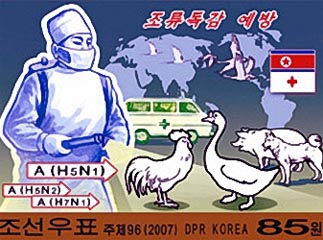
AFP
Philippe Agret
5/2/2007
SARIWON, North Korea (AFP) – To cope with the pouring rain, the hospital tossed sawdust down the stairway leading to the operating theatre.
Two surgeons washed their hands in a sink, but sometimes they lack soap.
Much like the rest of North Korea, a political pariah and economic black hole, the nation’s hospitals subsist with whatever they can get their hands on, making ends meet with obsolete equipment, short-cut procedures and a smattering of foreign assistance.
Even by the standards of the developing world, the facilities here in Sariwon, a 45-minute drive south of the capital Pyongyang, leave much to be desired.
The medical equipment is largely German or Soviet, reused as long as possible, but spare parts are desperately lacking.
“As we lack sufficient or working equipment, we use local anaesthesia and acupuncture for operations,” said the director of the Sariwon hospital, Dr Choe Chol, a surgeon.
In winter, surgeons operate in rooms where the temperature is lower than five degrees Celsius (41 Fahrenheit).
To improve conditions, the doctors and nurses pitch in themselves to make the hospital work, sometimes even laying down the tiling in the operating theatres.
“We do our best here. There’s no bleach, no soap, no disinfectant. We cleanse with distilled water. It’s the volunteers — the doctors and nurses — who regularly do the cleaning up,” said Veronique Mondon, the North Korea head of the French charity Premiere Urgence.
Premiere Urgence is one of only six foreign non-governmental organisations allowed to work in the Democratic People’s Republic of Korea.
Like others NGOs, the group has set a goal of bringing the most basic treatment to the population — but also to encourage North Koreans to develop their own medical infrastructure.
Premiere Urgence’s primary effort has been producing intravenous drips — one of the only medical supplies made in North Korea — for the 12 hospitals where it works.
With 70 to 80 percent of the medicine in North Korea coming from overseas donations, the IV drip — in the form of a packet with a solution of distilled water, glucose and sodium — serves to ease the impact of the lack of supplies.
“These packets can be used for a great number of the medical problems in North Korea such as accidents, malnutrition, dehydration, diarrhea, typhus and hepatitis. They save lives,” said Mondon, a biologist who opened Premiere Urgence’s branch in North Korea in April 2002.
If IV drips are effective, their production is a daily challenge. The packets must be sterilised on site in the most sanitary conditions possible, a process that takes about three and a half hours.
In light of the instability of the electricity and frequent short power cuts, Premiere Urgence has brought in specially made transformers from China.
“The people in the laboratories work during the night to produce the packets so as to save the electricity for the sick people and operations during the day,” Mondon said.
“It was tough at first. It seemed to be an insurmountable task. But now, the North Koreans know that this is needed,” she said.
After the April 2004 disaster in the northern city of Ryongchon, when a cargo train blew up, killing more than 160 people and wounding a thousand others, Premiere Urgence worked round the clock to produce IV drips and distributed 40,000 of them to two hospitals that were treating victims.
Today, the laboratory in Sariwon produces 300 IV drips a day — enough to treat more than 200 patients in this 750-bed hospital.
Across North Korea, Premiere Urgence produces 500,000 packets a year, each one worth around 50 US cents.
The French group has also set up a central laboratory in Pyongyang for quality control over injectable solutions.
North Korea’s communist leadership adheres to the homegrown ideology of “Juche” — self-reliance and self-sufficiency.
But at least hundreds of thousands of people died in a famine in the 1990s and North Korea has since relied heavily on foreign assistance — notably for food — despite continued political defiance, including its test of an atomic device in October.
From the International Committee of the Red Cross (ICRC) to the few NGOs in North Korea, all encourage local initiatives in an effort to prevent a culture of dependence.
Premiere Urgence plans eventually to hand over the maintenance of equipment and training of technical staff to the North Korean ministry of public health.
As for the ICRC, as well as helping produce 1,200 prosthetic limbs in 2006, it has focused efforts on training local people, including orthopaedic specialists and surgeons.
“North Korea’s pharmaceutical industry will never be able to develop if humanitarian groups flood North Korea with foreign medicine. It will continue to vegetate and manufacturer substandard products if foreigners do not buy local medicine,” said Felix Abt, a Swiss businessman who heads PyongSu Pharma JV. Co Ltd., one of the first foreign joint ventures in North Korea.
Pyongsu has set up a “model” pharmacy in Pyongyang and since September 2004 has run a factory with 30 employees manufacturing paracetamol, the pain relief drug sold under name brands such as Tylenol, along with aspirin and antibiotics.
Abt hopes one day to be able to export medicine from North Korea.
“For now, we are giving the North Koreans fish. It would be better to give them nets so they can catch fish,” Abt said.









